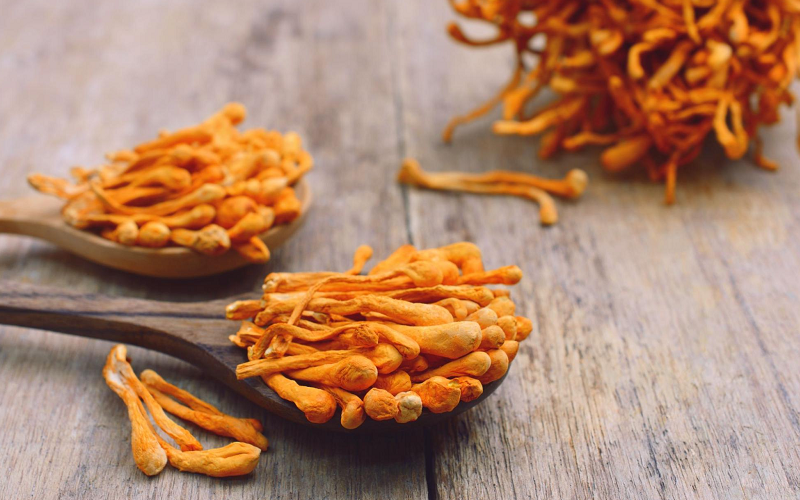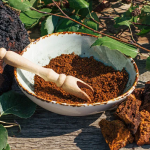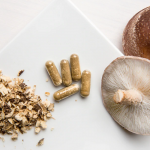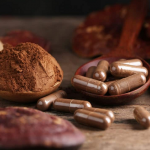Referred to by some as Himalayan Gold because they are harvested in the Himalayan plateaus, cordyceps mushrooms have been used in ancient Tibetan and Chinese medicine for over a thousand years. In Traditional Chinese Medicine (TCM) cordyceps were considered a cure-all that were used to treat cough, headache, fatigue, liver disease, low libido, and much more. Only in the last decade or so has the Western world come to understand the many health benefits of this special fungi.
Contents
What Are Cordyceps Mushrooms?
Cordyceps (scientific name Ophiocordyceps sinensis and also referred to as caterpillar fungus or caterpillar mushroom) grow in greatest abundance in Tibet and some areas of China, but can also be found to a lesser extent in other places including India and Nepal.
Cordyceps aren’t technically a mushroom — it’s more accurate to call them a mushroom-like fungus. You won’t find many people who don’t refer to cordyceps as mushrooms, so to avoid confusion we’ll go along with the crowd. Mushroom it is!
If they aren’t really a mushroom, what are they? Cordyceps are entomopathogenic fungi, which means that they are a fungi that are … wait for it … parasitic organisms that grow from within insects! That’s a pretty bizarre and fascinating (as well as somewhat disgusting) concept, so it deserves at least a short explanation.
Spores from cordyceps infect a variety of insects, with caterpillars being their primary “victim.” As the spores germinate, thread-like filaments enter the host insect and begin to consume the insect from the inside. Eventually the slender fruiting body of the fungi protrudes from the insect’s head. The cordyceps continues to grow from the now-dead host insect, and will eventually release spores to repeat its life cycle.
Cordyceps require a very precise, specific set of conditions to grow and, even when those conditions are met and the fungi grows to full size, they’re relatively small. This makes the large-scale collection impossible and, until recently, has made cordyceps one of the most expensive medicinal mushrooms in the world. In the past cordyceps have been difficult to cultivate, but recently a process to effectively grow them on a commercial scale has been developed. The result is that the price of cordyceps has dropped considerably, though they still cost a little more than most other medicinal mushrooms.
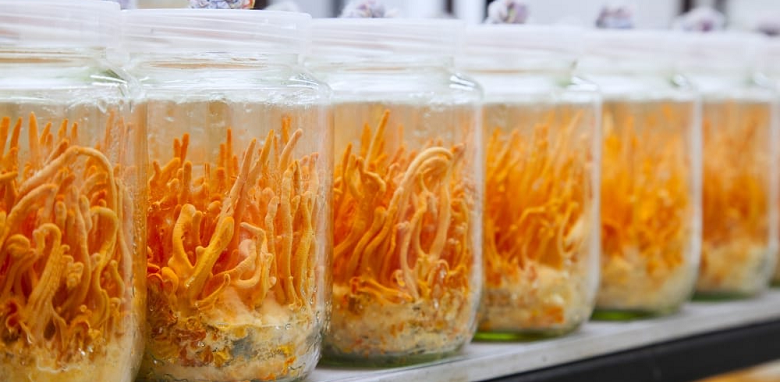
Cordyceps Mushrooms Health Benefits
Cordyceps have been used for over a thousand years in Traditional Chinese Medicine (TCM) and Tibetan medicine. It’s been considered a true cure-all, and as such is not known primarily as a treatment for one particular health issue.
The Chinese have used cordyceps to heal kidney, heart, liver, and lung diseases, and to treat cancers, fatigue, and sexual dysfunction. They’ve also been believed to enhance general health and well-being, and promote longevity.
As the price of the once prohibitory priced mushroom dropped, and Eastern medicine started to gain a greater acceptance in the Western world, cordyceps consumption — and research — has greatly accelerated in North America. Now, people in the United States commonly use cordyceps to improve athletic performance and increase energy, treat sexual problems and anxiety, and as an anti-aging supplement.
Cordyceps Increases Energy
Cordyceps provide numerous health benefits, so it’s hard to pick one for which this mushroom is best known. If forced to pick a “best known for” it might be its ability to increase energy (which also typically results in improved physical performance and activity).
One compound in cordyceps that contributes to a boost in energy is cordycepin. Cordycepin is a powerhouse of a chemical, with strong anti-inflammatory, antioxidant, and anti-cancer properties. Its ability to increase energy comes from the fact that it mimics caffeine (but with no jittery side effects) in that it binds to the cell receptors that normally latch on to adenosine, a chemical that is considered our “sleepy compound.” By replacing fatigue-inducing adenosine with energy-boosting cordycepin, cells trigger the body to feel more awake rather than more tired.
A second way in which cordyceps increases energy has to do with ATP. Adenosine triphosphate, or ATP, is the most basic form of energy that powers cells. ATP delivers energy to all of the cells in the body, so that of course includes the cells that make up muscles.
One study has shown that cordyceps increases energy by upping ATP production. The study also showed that cordyceps improves the transport of oxygen to muscles and increases lung capacity increasing endurance and preventing fatigue.
Cordyceps is also known to be a powerful antioxidant that lowers cholesterol. A build up of cholesterol causes the formation of plaque within blood vessels, which lowers blood circulation and depresses cardiovascular function. The effect is a decrease in aerobic and exercise performance.
Cordyceps Calms Anxiety
Anxiety is a major health issues. Over https://www.nami.org/About-Mental-Illness/Mental-Health-Conditions/Anxiety-Disorders”>40 million people in the U.S. alone have some type of anxiety disorder. In response to this, the pharmaceutical industry has developed a number of prescription anti-anxiety drugs, including diazepam (Valium), clonazepam (Klonopin), and alprazolam (Xanax).
While these medications can be effective for many people, these drugs are also often accompanied by side effects — some of which can be very severe. Confusion, drowsiness, and clumsiness are common complaints, even at low doses of medication, while higher doses can cause sexual dysfunction, weight gain, or gastrointestinal problems. And with long-term use there is always a risk of addiction.
Because of the many downsides of prescription anti-anxiety medications, recent years have seen a wealth of research into new, more natural anxiety treatments — including several species of medicinal mushrooms. The most well-known of these treatments involve mushrooms that contain psilocybin — a natural psychedelic prodrug. A prodrug is a biologically inactive compound that the body metabolizes to produce a drug.
Understandably, many people are scared off by the mention of psychedelic drugs — whether they be synthetic or naturally occurring in mushrooms. Fortunately it turns out that it’s not only so-called “magic mushrooms” that can benefit sufferers of anxiety — some species of mushrooms have anti-anxiety effects without including psychoactive compounds like psilocybin in their makeup. Cordyceps is one such mushroom.
One way in which cordyceps helps with anxiety is in its anti-inflammatory effects. Research has shown a definite link between inflammation and several mental health disorders, including anxiety. People suffering with depression or anxiety often have above-average levels of pro-inflammatory chemicals called cytokines. Some mushrooms, including cordyceps, can modulate the immune system to lower inflammation.
Cordyceps are considered an adaptogen, which is another reason this mushroom has anti-anxiety effects. An adaptogen is a root, herb, or fungi that has properties that naturally assist the body in dealing with — or adapting to — stressors of all types. Adaptogens like cordyceps have positive effects on stress-related hormones. These hormones, which include epinephrine and adrenaline, are released by the adrenal glands in response to stress. How much of these hormones is produced is regulated by the hypothalamus and pituitary gland. Cordyceps in particular is able to help balance pituitary and hypothalamus stress response, making the adrenal glands more effective in their release of stress-related hormones.

Cordyceps Benefits Men’s Sexual Health
Cordyceps have over a thousand year history of use in China as both an aphrodisiac and a sexual tonic. Grown throughout the mountainsides of the Himalaya, cordyceps have even acquired the nickname Himalayan Viagra. While it sounds like a bit of a myth, clinical evidence backs up the claims of improved sexual health — especially for men.
There are a few other mushrooms, including reishi, that are known to be of benefit to male sexuality, but cordyceps may be the fungi that comes out on top in this area.
Cordyceps are a potent hypotensive (something that reduces blood pressure) that reduce blood pressure, lower cholesterol, and decrease stroke risk. This mushroom is beneficial to the cardiovascular system, and along with healthy blood vessels comes better blood supply to the genitals which can increase both sexual arousal and pleasure.
Better blood flow helps male sexuality, and so does better oxygen transport. We mentioned above that cordyceps increases ATP (adenosine triphosphate) production, improving oxygen transport to muscles and in turn supplying a stamina boost. The increased oxygen and stamina don’t apply just to mental energy — the stamina boost also contributes to improved libido and sexual desire, and can reduce symptoms of impotence.
Cordyceps have the ability to improve male fertility be increasing sperm production. The protein structure in cordyceps is similar to luteinizing hormone, which plays a vital role in the function of the testes in men. Luteinizing hormone, and thus the similar proteins in cordyceps, are responsible for stimulating spermatogenesis — the production, or development, of sperm. Studies have demonstrated that male patients with low libido (sexual drive) treated with daily cordyceps had both an increase in sexual desire and a marked increase in sperm count in less than two months.
Cordyceps also play a role in male testosterone production. The mushroom boosts testosterone by stimulating Leydig cells — the cells that are responsible for both the production and secretion of testosterone. Cordycepin (introduced above in the Cordyceps Increases Energy section) is the compound in cordyceps mushrooms responsible for this Leydig cells stimulation, and thus for the boost in testosterone levels in men.
Cordyceps Have Anti-Aging Properties
For centuries many parts of the Asian world have considered cordyceps a longevity fungi that helps slow the aging process. We now know that due to cordyceps abundance of diverse antioxidant compounds, this mushroom can in fact be used as an anti-aging supplement.
Free radicals — also called reactive oxygen species, or ROS — are unstable molecules that can interfere with cell function by damaging the cell’s DNA. One popular aging theory is that this oxidative stress that free radicals causes is the primary contributor to the aging process.
While almost all discussions of free radicals only mention the bad of free radicals, it should be known that free radicals do have a positive purpose. The cell-damaging properties of free radicals are used by the immune system to destroy pathogens — viruses and bacteria that cause disease and illness.
So it’s not that free radicals are inherently bad. Rather, the problem comes when the number of free radicals vastly exceeds the number of antioxidants — antioxidants being specialized molecules that are capable of neutralizing free radicals to keep their numbers from reaching body-damaging numbers. When the numbers of free radicals and antioxidants become unbalanced, free radicals begin to do the damage that’s associated with aging.
Polysaccharides are a type of complex carbohydrate, and also act as very powerful antioxidants that have been shown to have anti-aging properties. And it turns out cordyceps are extremely rich in polysaccharides. Polysaccharides have significant antioxidant and anti-inflammation properties that can prevent age-related neurodegenerative diseases such as Alzheimer’s disease and Parkinson’s disease.
Polysaccharides also play a key role in lessening cellular senescence — the damaging and death of cells that occur over time. Damaged cells and cells dying contribute to many age-associated illnesses and diseases. That means the polysaccharides in cordyceps mushrooms can contribute to healthier and longer-lived cells, resulting in an anti-aging effect.
How to Consume Cordyceps Mushrooms
Cordyceps have a somewhat bitter and earthy taste that some people enjoy, but as far as flavor goes they certainly aren’t as well-liked as a mushroom like shiitake. So more often than not, someone interested in the medicinal benefits of cordyceps consumes this mushroom in the form of a powder extract. Cordyceps powder can be added to coffee or hot tea, or added to your favorite fruit drink or smoothie.
There is no strict guidance as to what constitutes a dose of cordyceps, but the general consensus is that 1 to 3 grams (1000 to 3000 mg) per day is appropriate. Cordyceps are a very safe supplement so a higher doses would be acceptable, but the 1 to 3 grams amount provides the health benefits discussed in this article. The health benefits of this fungi accumulate over time, so you should plan on being in it for the long haul — be sure to take cordyceps daily for a few months before assuming it isn’t having great effects and giving up on it.
Cordyceps Mushrooms Side Effects
Cordyceps are considered a very safe supplement. Taken in the recommended range of 1 to 3 grams per day, it is extremely unlikely that a person will experience any side effects. At much higher doses mild stomach discomfort could be an issue.
One of the health benefits of cordyceps comes from their anti-platelet aggregating effects — in simpler terms they reduce blood clotting, which lowers blood pressure. That’s normally a good thing, but if a person has a bleeding disorder or is about to undergo surgery they should avoid taking cordyceps.


